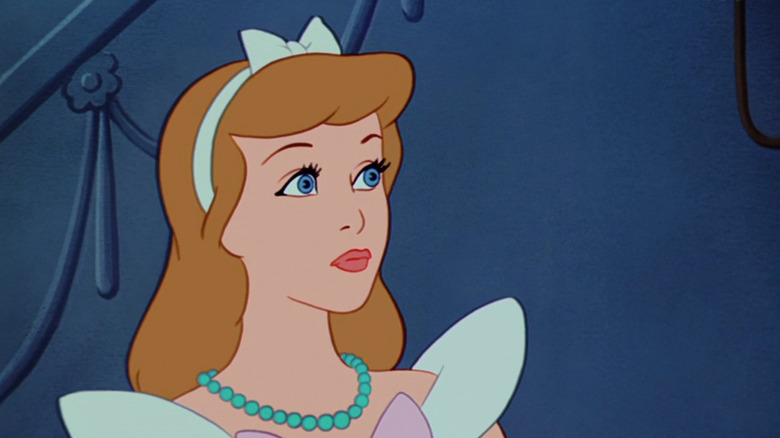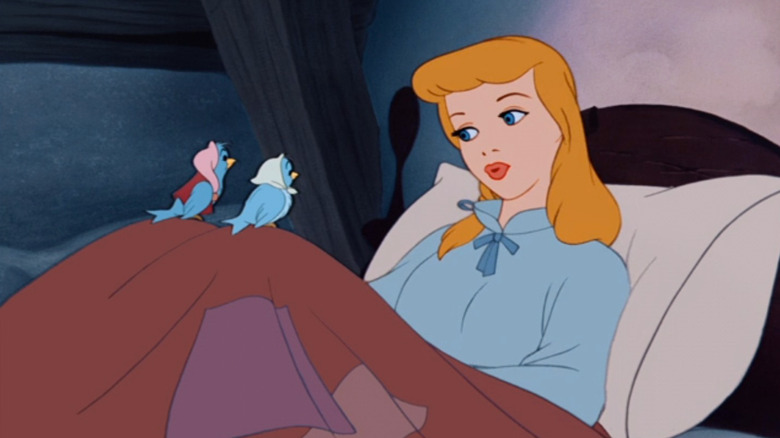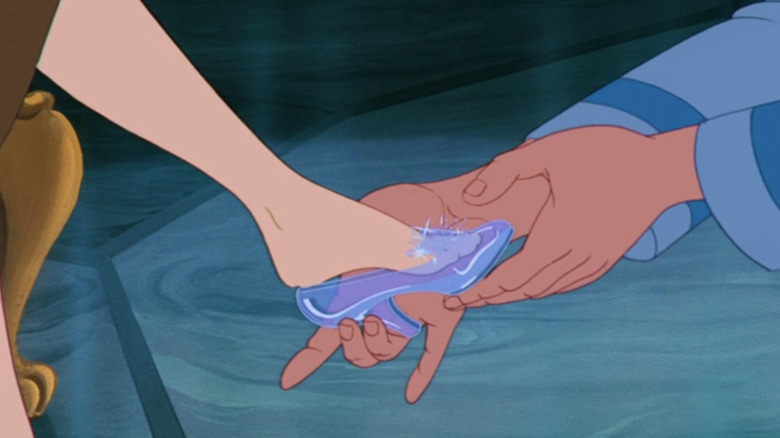Without The Success Of Cinderella, Disney Would Have Likely Folded In The 1950s
As a little girl, I loved watching "Cinderella." It wasn't the princess thing or the handsome prince who comes to save her that appealed to me. I liked the talking mice and birds who helped make her dress, her sparkly shoes, and the idea of a fairy godmother who could help a girl out of a crappy situation. Oh, and those very pretty dogs she gets at the end, which I remember more from the book that went along with the film.
It wasn't until years later that the whole idea of being rescued by a man/abusive treatment of a young woman/princess fantasy started to chafe. Ultimately, it doesn't matter why I liked it as a little kid. I just did, and I was hardly alone. The animated Disney film is considered a classic, despite the reexamination many of us have done over the decades since its release in 1950.
Over seven decades later, it's hard to imagine a time when a film like "Cinderella" was a huge risk for Disney, but it was. In fact, if the title hadn't done well, it could have destroyed the company or, at the very least, shut Disney Animation down for good.
A dream is a wish your heart makes
First, a little history. Production began on "Cinderella" in 1948 and took two years to finish. It's based on the version of the story by French author Charles Perrault in "Histoires ou contes du temps passé" from 1697. It was first written down (so far as we know) in 1634 by Italian author Giambattista Basile in "Pentamerone." The earliest version of the tale is from the Greek geographer Strabo from late in the first century BCE or early in the first century CE. It's about a young enslaved Greek woman who marries the king of Egypt, and also involves a shoe. Well, okay, a sandal.
If by some miracle you don't know the story, the version that most of us are familiar with has a young woman whose mother has died. Her father remarries, and when he dies, her stepmother and two stepsisters take all her possessions and turn her into their maid. She's later locked away when the King invites all marriageable young women to a ball to find a wife for the Prince. (If you're gagging, you are not alone.) A fairy godmother (or, in some versions, the ghost of her mother) gives her a dress and transportation (in the Disney version, she turns Cinderella's animal friends into servants and a pumpkin into a carriage). She meets the Prince, and they fall in love. No one recognizes her all gussied up, of course. The spell ends at midnight, and when she runs out, she loses a glass slipper. The Prince uses it to find her because her feet are so tiny.
Some versions have the stepsisters cutting off their toes and part of their heel to fit into the tiny glass slipper. Fairy tales are weird.
Bibbidi-bobbidi-boo
Disney had great success with the 1938 animated feature "Snow White and the Seven Dwarfs," which won a unique Oscar (with tiny little Oscar statues symbolizing the dwarves) and was an immediate box office success. Naturally, being the first-ever animated feature film, it seemed like this was the way of the future for the Mouse House.
However, when WWII broke out, it drastically affected the box office for the studio's next offerings, according to a feature published by the LA Times in 1987. "Pinocchio" only made $1.4 million against a $2.3 million budget in 1940, with the equally-costly "Fantasia" not even hitting that mark in the same year. 1942's "Bambi" did better but still wasn't making enough with no international market, and Disney was millions of dollars in debt.
Disney had to turn to making films with the United States Department of State, which is another article altogether. The company put off "Cinderella" for a bit, but this was a story people knew and loved. The hope was that it could possibly change the company's fortunes, though it was a huge risk for Walt Disney.
The decision was made to shoot the whole thing in live-action first before animating the film. That hadn't been done before, but it gave the animators excellent references for the movement of the characters. That led to fewer mistakes and less time needed to complete their work. As someone who lives with an artist, I (and my cats) have been filmed several times for movement reference, and most animators have a mirror by their desks for facial expressions. Nowadays, it's a fairly standard thing to do.
So this is love
"Cinderella" ended up as a smashing success for Disney, though exactly how much varies depending on the source. The LA Times feature claimed it grossed over $4 million off of a $2 million dollar cost. A Decider article for the 70th anniversary of the film said it made $8 million. Box Office Mojo lists its gross as $10 million. Whatever the truth of the actual dollar amount is, it was enough to keep Disney's animation studio alive and well.
The film has been re-released a number of times and remade in various ways, including the 2015 live-action version starring Lily James and the 1998 film "Ever After" starring Drew Barrymore. One can argue endlessly (I certainly have) that Disney princess films have given rise to unrealistic ideals. That debate will continue forever, but the idea stands out that someone kind is rewarded (a questionable reward, but still) in the story, while those who are mean are punished. (Some versions have the stepsisters getting their eyes pecked out by birds.) Whatever you think of the story, the idea of wearing shoes made of freaking glass, or the bad reputation this and other fairy tales have given stepmothers (yet another article), it certainly changed the landscape of animation.
Now, excuse me while I go try to convince the hummingbirds I feed to tie some ribbons in my hair. Hey, it worked for Cindy!



